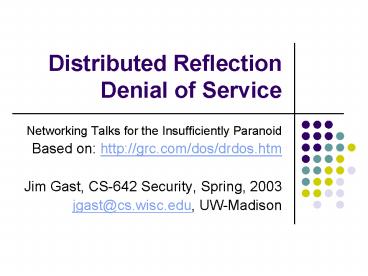Distributed Reflection Denial of Service - PowerPoint PPT Presentation
Title:
Distributed Reflection Denial of Service
Description:
Infect innocent bystanders (zombies) Zombies listen (e.g. on IRC channel) for ... Coordinate zombies to attack with big packets. Use up 'last-hop' bandwidth ' ... – PowerPoint PPT presentation
Number of Views:253
Avg rating:3.0/5.0
Title: Distributed Reflection Denial of Service
1
Distributed Reflection Denial of Service
- Networking Talks for the Insufficiently Paranoid
- Based on http//grc.com/dos/drdos.htm
- Jim Gast, CS-642 Security, Spring, 2003
- jgast_at_cs.wisc.edu, UW-Madison
2
Normal Connection Establishment
The Server sets up retransmission timers,
allocates receive buffers, etc. Imagine a web
server that can handle 12,000 connections. If
the process fails, a timeout occurs after 120
seconds, freeing up the resources.
Note SYN packets are very small and take up very
little bandwidth.
Graphics stolen from http//grc.com/dos/drdos.htm
3
State Transition Diagram
4
SYN Flood
- Each SYN creates one half-open connection
- Half-open connections take minutes to time-out
- Servers have finite connection tables
- Perpetrator would be easily caught (Source IP)
- Unless SourceIP is spoofed
- See CERT Advisory CA-1996-21
- http//www.cert.org/advisories/CA-1996-21.html
100 SYN packets per second fits in 56 Kbps
Graphics stolen from http//grc.com/dos/drdos.htm
5
Spoofed IP Address
The SYN/ACK is delivered to the fake (spoofed) IP
Address. The attacker doesnt see it, and doesnt
care. (Backscatter)
Graphics stolen from http//grc.com/dos/drdos.htm
6
Example SYN Flood Attack
- February 5th-11th, 2000
- Victims included CNN, eBay, Yahoo, Amazon
- Attackers (allegedly) used simple, readily
available tools (script-kiddies) - Law enforcement unable (unwilling?) to help
- Under-age perpetrators have blanket immunity
7
Defense against SYN Flood
- Increase size of connection table
- Add more servers
- Trace attack back to source
- Ask your ISP to filter malicious packets
- Add firewall
- Typically SYN proxy
- Dave Parter will talk on firewalls later in the
semester - Ultimate solution was SYN-cookies
- Reply to SYN with SYN-cookie
- Allocate no resources until SYN-cookie is
returned
8
Potential places to stop DoS flood
Graphics stolen from http//grc.com/dos/drdos.htm
9
Distributed DoS
- Rather than filling connection table, fill all
available bandwidth - Infect innocent bystanders (zombies)
- Zombies listen (e.g. on IRC channel) for attack
command (or simply attack at will) - Attacker need not have high bandwidth connection
Typical Program EvilGoat EvilBot
Graphics stolen from http//grc.com/dos/drdos.htm
10
Example Distributed DOS Attack
- 6 attacks on 5 different days
- One attack lasted for 17 hours
- 474 infected windows PC as zombies
- 2.4 billion malicious packets
Goodput?
Time (minutes?)
Graphics stolen from http//grc.com/dos/grcdos.htm
11
Flood-based Distributed DoS Attacks
- Coordinate zombies to attack with big packets
- Use up last-hop bandwidth
- Last-hop router discards packets
indiscriminately - Zombies need not spoof addresses
See http//grc.com/dos/intro.htm for example
horror story
Graphics stolen from http//grc.com/dos/drdos.htm
12
Newest Twist - Reflection
- Many routers accept connections on port 179
(Border Gateway Protocol) - Although any big server and any port it listens
on will work - Send a SYN to a router, claiming it came from the
victim - The router will send a SYN/ACK to the victim
- And then re-transmit several times before giving
up (typically about 4X)
Note Tar-pits will not see any Backscatter but
honey-pots might see the attackers commands.
13
Reflection Mechanism
Graphics stolen from http//grc.com/dos/drdos.htm
14
Distributed Reflection DoS
Graphics stolen from http//grc.com/dos/drdos.htm
15
Other ports susceptible to DRDoS
- 22 Secure Shell
- 23 Telnet
- 53 DNS
- 80 HTTP / Web
- 4001 Proxy Servers
- 6668 Internet Relay Chat
Easily detected ports 1-1023
Well-Known (so far)
But reflection from port 179 is so powerful it
easily overwhelms others
16
Call to action
- Ingress filtering at all ISPs would stop the
spoofed SYN packets before they left home - Egress filtering at all ISPs would prevent
spoofed IP addresses from traversing the Internet - Flagging multiply-tried, failed SYN/ACKs could be
used to discover victims and filter further
attack - Disable raw socket interface in client PCs
17
Questions?































